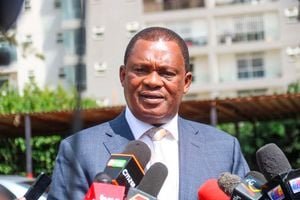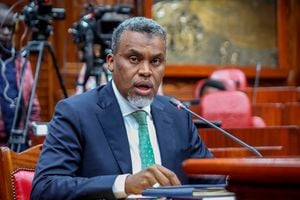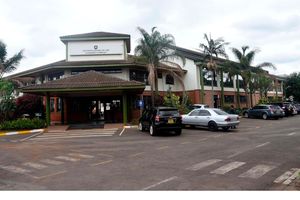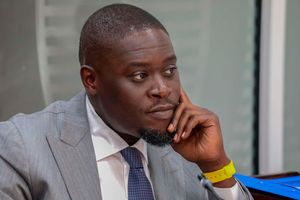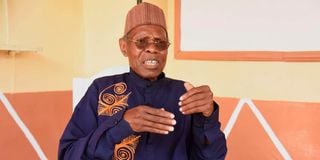
Koigi Wamwere during an interview with The Nation at his Sauti ya Mwananchi offices in Nakuru County on October 17, 2023.
While reading a book in a Ugandan hotel in 1990, exiled Koigi wa Wamwere noticed the key turn on his door. Five hooded men stormed in, punching and restraining him. Overpowered and drugged, Wamwere blacked out. On regaining consciousness, Kenya’s most wanted dissident was en route to Nairobi, the latest prize in President Daniel arap Moi’s crackdown on dissent.
Internal and cross-border abductions continue if you think of Ugandan opposition chief Kizza Besigye’s recent abduction in Nairobi and brief kidnapping of Tanzania journalist Maria Sarungi.
Since its formation in the 1950s, the Special Branch – a ruthless arm of the colonial state created to quash Mau Mau – and its successor, the National Intelligence Service (NIS), perfected abduction, torture and psychological warfare as tools of trade.
Under colonial rule, the brutal methods of the intelligence agency left a trail of death and terror across Mt Kenya, where real and imaginary critics paid the ultimate price.
Thousands of corpses bore testimony to the reign of terror – a history concealed in colonial archives for decades. The same reign would be captured in the harrowing tales we hear from Nyayo House torture chambers.
Damning evidence
Last week’s claims by Cabinet Secretary Justin Muturi that NIS abducted his son and that Leslie Muturi was only released after the CS confronted President William Ruto with damning evidence casts a shadow on the modus operandi of the spy agency. While ordinary families, those still searching for missing youth, have no such privileged access, they are in the space Koigi’s mother Wangu Wamwere found herself as she led kin of political prisoners to demand their release.
It is clear that even the promulgation of the 2010 Constitution, a landmark moment for human rights, failed to end the culture of oppression. Hopes that the NIS would abandon the tactics of its predecessors – the Special Branch and Directorate of Security Intelligence – have faded. What we have is a system increasingly resembling George Orwell’s Animal Farm, where power is the ultimate privilege and for Kenya’s most vulnerable, justice remains a distant dream.
The NIS and Special Branch have been involved in kidnappings and attempted assassinations. Koigi is a case study as he has chronicled his experience in his book: I Refuse to Die.
On July 10, 1986, former Nakuru North MP slipped out of Kenya through at Malaba border, heading into exile. On arrival in Uganda, he sought asylum and was placed under UN protection. But danger followed.
“When Kenyan security forces learned of my presence in Uganda, they gave chase,” Koigi recalled.
Realising the threat, the UN moved him from the city centre to Seta Travellers Lodge on the outskirts of Kampala. Still, the pressure from Nairobi mounted.
Uganda’s Deputy PM Elijah Kategaya eventually advised Koigi to leave, admitting his safety could no longer be guaranteed.
After two months of dodging abductors, Koigi and journalist Kariuki Wang’ondu, a fellow former detainee, fled to Norway on September 16.
Exile offered little respite. One day, Koigi received a call from a man claiming to be Bishop Byrum Makokha.
“I am in Oslo seeking political asylum. Things are bad at home,” the caller said.
Koigi met him at Oslo railway station and even hosted him. The pair met frequently over the next two weeks, and Koigi arranged for the man to give an interview with the BBC. However, the “bishop” hesitated, citing fears for his “allies” in the army, who he said were plotting a coup.
After much persuasion, the “bishop” agreed to two interviews. After the first Kiswahili broadcast, however, the real Bishop Byrum Makokha contacted the BBC, exposing the imposter.
As fate would have it, Koigi had been unwittingly fraternising with an intelligence operative whose sinister mission later unravelled. The agent, under the guise of camaraderie, admitted to having orders to abduct Koigi.
This was not the first time Special Branch had deployed kidnappers. Before the Byrum Makokha saga captured global attention, Koigi had encountered another would-be abductor: Sammy Korir.
Korir later confessed, under the glare of Norwegian National TV, that he had been dispatched with a chilling directive – To board the same plane as Koigi and hijack it to Tanzania.
“When I met Koigi and his family, my conscience revolted,” Korir said, abandoning his mission.
In Kenya, the crackdown on Mwakenya – a clandestine opposition movement – was in full throttle, igniting an era of torture chambers and detention without trial.
Though Koigi was not affiliated with Mwakenya, he later predicted his inevitable fate had he remained in Kenya.
“Many friends in Nakuru and Nairobi were arrested and tortured into falsely confessing that I had recruited them and administered the Mwakenya oath,” Koigi recounted in I Refuse to Die.
His resignation from Kanu as a life member on March 26, 1987, and subsequent allegiance to the Kenya Patriotic Front, painted a target on the backs of his associates. Among the victims of this guilt by association were Gibson Maina Kimani, Milton Chege and Koigi’s cousin Koigi wa Kariuki, all sentenced to seven years in prison. Their crime? Smuggling Koigi’s wife, Nduta, to Tanzania after her passport had been confiscated at Jomo Kenyatta International Airport. Nduta had also faced the wrath of the intelligence.
“Find another man, marry, and let that fool freeze to death in Norway. You’ll never travel again,” immigration officers sneered at Nduta after taking her passport.
Opponents of the Nyayo regime were hunted with ferocity and a countrywide demo was organised to denounce Koigi and Prof Ngugi wa Thiongo.
Even Hilary Ngweno’s pro-government Weekly Review dismissed Koigi as a “disgruntled loser” who had turned dissident after failing to reclaim the Nakuru North seat in the 1986 by-election. The publication painted a similarly dismissive picture of Prof Thiong’o, branding him a “confused ideologue of dubious political inclinations”.
A more insidious plot emerged by May 1988. A plan to eliminate Koigi was hatched in Nairobi.
Koigi later recounted: “The most serious attempt to capture me involved Kibily Tall.”
Tall, tasked with assassinating Koigi, arrived at Oslo Railway Station armed with a G3 automatic rifle, hundreds of rounds of ammunition, and a bulletproof vest.
A misstep at the station, however, led him to speak to the wrong person. His arrest was swift, and the arsenal was seized. Koigi later met the man, seeing the deadly tools intended for his demise. Tall confessed to Norwegian police to being sent on the murderous mission and was subsequently convicted for illegal possession of firearms before being deported to France.
Then came Koigi’s fateful mistake in September 1990 – an ill-advised journey to Uganda to meet his cousin. While enjoying drinks near Busia, Koigi spotted a group that bore the unmistakable air of Kenyan operatives.
“That night, as I lay on my bed reading, I heard the key in the door turn,” he recounted.
“In an instant, the door burst open and five hooded men pounced on me. I fought back, kicking and struggling, but they pinned me down. They blindfolded me with a thick, opaque cloth, and taped my mouth with an adhesive reeking of chemicals. I lost consciousness.”
The news of Koigi’s capture made headlines in Kenya, though intelligence sources claimed he had been apprehended in Nairobi. It was the start of a lengthy ordeal with dramatic appearance in courts.
That Koigi was kidnapped from another country failed to move the court – which said there was no evidence.
Indeed, Koigi was lucky to have survived the ordeal. Many of his friends died – and others were silenced forever.
Today, Muturi is telling us that the NIS kidnapped his son. The more things change, the more they remain the same.
[email protected]; @johnkamau1

